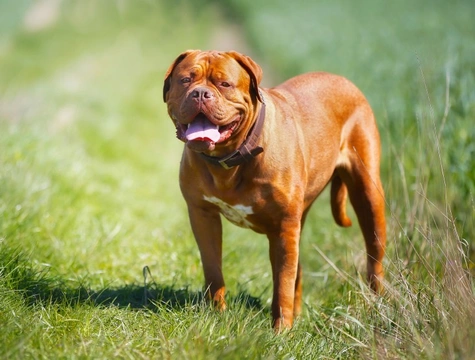
Dogue de Bordeaux hereditary health and longevity
The Dogue de Bordeaux is a large mastiff-type dog that originated in France, and is also sometimes referred to as the French mastiff. They are large, stocky and muscular dogs, with a thick-set body, heavily boned legs and small paws. They stand up to 27” tall for males, and 25.5” tall for females, and can weigh up to 52kg. The coat of the breed is short and fine, and a deep copper red in colour.
Historically, the Dogue de Bordeaux has a strong working history, in various roles including guarding, watchdog roles and as a pack carrier. However, today the breed is most widely owned as a pet, and can be seen in significant numbers within the UK as well as further afield. The Dogue de Bordeaux is popular among lots of different types of owners, thanks to their handsome appearance, strong guarding abilities, and kind, loyal natures. However, like all pedigree dog breeds, the Dogue de Bordeaux can suffer from a range of hereditary health problems that can affect the ways in which they need to be cared for, and which can potentially pose problems for the dog in different ways.
If you are considering buying a Dogue de Bordeaux, it is of course vital to find out as much as you can about the breed first, including looking into their longevity and hereditary health. In this article, we will look at these factors in more detail. Read on to learn more.
Dogue de Bordeaux longevity
The average life expectancy of the breed is just 5-6 years, which is an incredibly short lifespan for a pedigree dog, even when compared to other breeds of a similar size and build. The oldest recorded dog of the breed reached 12 years of age, and the Dogue de Bordeaux society of America actively records figures on the number of dogs of the breed to live past the age of 7, as their lifespan tends to be shorter than this.
Dogue de Bordeaux genetic diversity
The coefficient of inbreeding statistic for the Dogue de Bordeaux is 6.5%, which is just a touch higher than the ideal of 6.25% or lower. This indicates that the Dogue de Bordeaux breed as a whole is relatively genetically diverse, and is not subjected to a significant degree of inbreeding. Genetic diversity helps to improve the robustness and overall health of the breed, and so all potential breeders should strive to keep the coefficient of inbreeding statistic as low as possible within their own breed lines.
Dogue de Bordeaux conformation
The shape, size and physical appearance of the breed itself make the breed prone to a few conformation problems and specialist requirements, which potential owners should be aware of. These include:
- Significant drooling due to the structure of the lips.
- Issues with breathing normally and staying cool enough in hot weather, due to the brachycephalic face.
- A potential for unsoundness if the weight of the dog exceeds the capabilities of the leg muscles.
- Flaws within the shape of the eyes can cause damage and a propensity to eye infections.
- The facial skinfolds of the breed tend to collect moisture and dirt, which can lead to infections.
Health testing for the Dogue de Bordeaux
Various different health tests and health schemes are in place for the Dogue de Bordeaux breed, in order to identify the presence of hereditary health problems prior to breeding. These include:
- Hip score testing, with the average hip score of the breed being 21.2. This is a very high figure, and breeders should aim to only breed dogs that achieve a much lower score.
- Elbow score testing, with the ideal being zero.
- DNA testing for multifocal retinopathy.
- The Dogue de Bordeaux is also one of fifteen breeds classed by the UK Kennel Club as “high profile,” meaning that they are monitored due to their conformation, hereditary health and short lifespan being of concern.
Other health issues across the breed
The Dogue de Bordeaux has also been identified as having a propensity to develop various other conditions and problems too, although no pre-breeding screening is currently available to diagnose these. Such conditions include:
- Epilepsy, which may be able to be managed with medication. Dogs with epilepsy or a breed line history of epilepsy should not be bred from.
- Cruciate ligament weakness, which can lead to ligament damage, pain and lameness.
- Ectropion, a condition of the eyes that causes the eyelids to turn outwards, leading to pain and soreness.
- Degeneration of the heart muscles, known as dilated cardiomyopathy.
- Aortic stenosis, when the blood flow to the aorta is obstructed.
- Juvenile kidney failure, known as glomerulonephropathy.
- Various immunodeficiency problems, which may lead to a propensity to respiratory infections and bacterial diseases.
- Hyperkeratosis of the pads of the paws, which causes the skin of the pads to become thick and hard.



